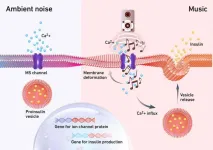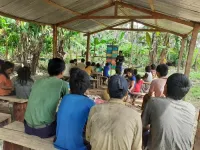(Press-News.org)
Diabetes is a condition in which the body produces too little or no insulin. Diabetics thus depend on an external supply of this hormone via injection or pump. Researchers led by Martin Fussenegger from the Department of Biosystems Science and Engineering at ETH Zurich in Basel want to make the lives of these people easier and are looking for solutions to produce and administer insulin directly in the body.
One such solution the scientists are pursuing is enclosing insulin-producing designer cells in capsules that can be implanted in the body. To be able to control from the outside when and how much insulin the cells release into the blood, researchers have studied and applied different triggers in recent years: light, temperature and electric fields.
Fussenegger and his colleagues have now developed another, novel stimulation method: they use music to trigger the cells to release insulin within minutes. This works especially well with “We Will Rock You,” a global hit by British rock band, Queen.
Equipping cells to receive sound waves
To make the insulin-producing cells receptive to sound waves, the researchers used a protein from the bacterium E. coli. Such proteins respond to mechanical stimuli and are common in animals and bacteria. The protein is located in the membrane of the bacterium and regulates the influx of calcium ions into the cell interior. The researchers have incorporated the blueprint of this bacterial ion channel into human insulin-producing cells. This lets these cells create the ion channel themselves and embed it in their membrane.
As the scientists have been able to show, the channel in these cells opens in response to sound, allowing positively charged calcium ions to flow into the cell. This leads to a charge reversal in the cell membrane, which in turn causes the tiny insulin-filled vesicles inside the cell to fuse with the cell membrane and release the insulin to the outside.
Booming bass boosts insulin secretion
In cell cultures, the researchers first determined which frequencies and volume levels activated the ion channels most strongly. They found that volume levels around 60 decibels (dB) and bass frequencies of 50 hertz were the most effective in triggering the ion channels. To trigger maximum insulin release, the sound or the music had to continue for a minimum of three seconds and pause for a maximum of five seconds. If the intervals were too far apart, substantially less insulin was released.
Finally, the researchers looked into which music genres caused the strongest insulin response at a volume of 85 dB. Rock music with booming bass like the song “We Will Rock You”, from Queen, came out on top, followed by the soundtrack to the action movie The Avengers. The insulin response to classical music and guitar music was rather weak by comparison.
“We Will Rock You” triggered roughly 70 percent of the insulin response within 5 minutes, and all of it within 15 minutes. This is comparable to the natural glucose-induced insulin response of healthy individuals, Fussenegger says.
Sound source must be directly above the implant
To test the system as a whole, the researchers implanted the insulin-producing cells into mice and placed the animals so that their bellies were directly on the loudspeaker. This was the only way the researchers could observe an insulin response. If, however, the animals were able to move freely in a “mouse disco,” the music failed to trigger insulin release.
“Our designer cells release insulin only when the sound source with the right sound is played directly on the skin above the implant,” Fussenegger explains. The release of the hormone was not triggered by ambient noise such as aircraft noise, lawnmowers, fire brigade sirens or conversations.
No triggering through ambient noise
As far as he can tell from tests on cell cultures and mice, Fussenegger sees little risk that the implanted cells in humans would release insulin constantly and at the slightest noise.
Another safety buffer is that insulin depots need four hours to fully replenish after they have been depleted. So even if the cells were exposed to sound at hourly intervals, they would not be able to release a full load of insulin each time and thereby cause life-threatening hypoglycaemia. “It could, however, cover the typical needs of a diabetes patient who eats three meals a day,” Fussenegger says. He explains that insulin remains in the vesicles for a long time, even if a person doesn’t eat for more than four hours. “There’s no depletion or unintentional discharge taking place.”
But clinical application is a long way off. The researchers have merely provided a proof of concept, showing that genetic networks can be controlled by mechanical stimuli such as sound waves. Whether this principle will ever be put to practical use depends on whether a pharmaceutical company is interested in doing so. It could, after all, be applied broadly: the system works not only with insulin, but with any protein that lends itself to therapeutic use.
END
When UCLA shifted to remote instruction during the early days of COVID-19, the campus was much less populated — but it wasn’t totally empty. Several species of animals continued to go about their daily lives, just with far fewer disturbances from humans.
Among them were around 300 dark-eyed juncos, a bird species that has thrived at UCLA for probably around 20 years.
A group of UCLA scientists who have been studying fear and aggression in urban juncos for years recognized that the dramatic shift in human activity presented a unique opportunity for an experiment: ...
Silicon is one of the most pervasive functional materials of the modern age, underpinning semiconductor technologies ranging from microelectronics to solar cells. Indeed, silicon transistors enable computing applications from cell phones to supercomputers, while silicon photovoltaics are the most widely deployed solar-cell technology to date. The U.S. Department of Energy (DOE) reports that nearly 50% of new electric generation capacity in 2022 came from solar cells, and according to the International Energy Agency (IEA), silicon has a 95% market share. Yet despite silicon’s ...
The number of local zoning ordinances governing renewable energy deployment is growing in the United States, according to new research by the U.S. Department of Energy’s National Renewable Energy Laboratory (NREL). The amount of land available to deploy renewables depends on the characteristics of the ordinances.
“It’s important to understand the types of ordinances in effect, specifically setback ordinances, or the required distance from a specific feature like a house,” said Anthony ...
(Boston) – Serum amyloid A (SAA) is a family of ancient proteins that can be traced from present-day humans back half a billion years to sea cucumbers and oysters. A new study by researchers from the Boston University Chobanian & Avedisian School of Medicine explores the link between the dual nature of this small plasma protein: how it works to clear toxic debris from wounds and inflammation sites, but also its role in forming fibrous deposits of the pathologic amyloid in vital organs such as the ...
In the United States and other western countries, a form of esophageal and stomach cancer has risen dramatically over the last five decades. Rates of esophageal adenocarcinoma, or EAC, and gastric cardia adenocarcinoma, or GCA, are both highly fatal.
However, Joel Rubenstein, M.D., M.S., a research scientist at the Lieutenant Colonel Charles S. Kettles Veterans Affairs Center for Clinical Management Research and professor of internal medicine at Michigan Medicine, says that preventative measures can be a saving grace.
“Screening can identify pre-cancerous changes in ...
https://www.scienceopen.com/hosted-document?doi=10.15212/AMM-2023-0016
Announcing a new publication for Acta Materia Medica journal. Cuproptosis is a newly identified specific form of programmed cell death. This study aims to identify cuproptosis-related genes (CRGs) in patients with kidney renal clear cell carcinoma (KIRC) from the The Cancer Genome Atlas database and to evaluate CRG biological functions. Using lasso regression, four KIRC prognosis-associated CRGs were identified and an associated prognostic risk signature was constructed. Kaplan-Meier curves showed that patients with ...
New Haven, Conn. — High levels of exposure to the virus that causes COVID-19 may reduce or overcome the protection that vaccination and prior infection provides, according to a new study by researchers from Yale University, the University of Florida, and the Connecticut Department of Correction.
The findings, published Aug. 19 in Nature Communications, suggest that in densely crowded settings, control measures that reduce levels of exposure to the virus — such as masking, improved ventilation, and distancing — may afford additional benefit in preventing new infections among people who have been ...
For his contributions to the aerospace community, Peyman Givi, Distinguished Professor of Mechanical Engineering and Materials Science at the University of Pittsburgh, was selected to present the 2024 Dryden Lecture in Research, by the Honors and Awards Committee and the Board of Trustees of the American Institute of Aeronautics and Astronautics (AIAA).
According to AIAA, the Dryden Lectureship in Research, established in 1961, is one of the Institute’s most prestigious lectureships and emphasizes the importance ...
BIRMINGHAM, Ala. – In osteoporosis, bones become brittle and fragile, putting them at high risk of fractures or breaks. These “fragility fractures” can cause pain, suffering, disability and even death, and patients have increased risks of repeat fractures. It is estimated that one in two women and up to one in four men experience a fracture in their lifetime due to osteoporosis.
Can an augmented health care delivery pathway reduce the chances of those future fractures and improve outcomes that are important to patients? Two University of Alabama at Birmingham researchers ...
(Santa Barbara, Calif.) — Indigenous peoples suffered disproportionately from the COVID-19 pandemic, experiencing a lack of sovereignty, limited infrastructure and discrimination in local healthcare systems that make them particularly vulnerable to infectious diseases. Yet little research exists to guide interventions and public health efforts tailored to remote-living Indigenous populations during pandemics.
In Bolivia, for example, a team of researchers including UC Santa Barbara’s Tom Kraft and Michael Gurven, and local collaborators, attempted to mitigate SARS-CoV-2’s impact on the ...



